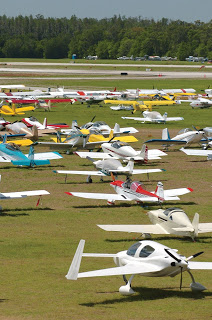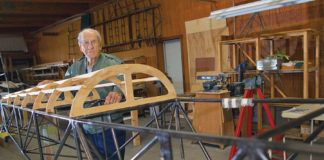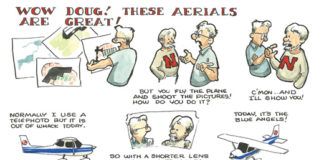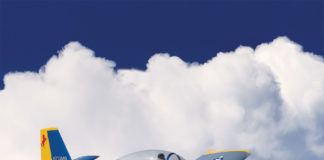
Things to Think About in Advance
Just about everybody knows that the human element is a major contributor in many aviation accidents and incidents. By thinking things through before the fly-in, there will be fewer surprising situations.
First, consider your main objective when attending a fly-in. It’s not putting the airplane exactly on the numbers when the controller tells you to, and it is not even attending the fly-in. Your main objective is to arrive alive and well and be able to fly your airplane the next day. This seems obvious, but aviation is filled with examples where pilots did not keep their primary objective in mind. Military pilots sometimes get “target fixation” and fly their airplane into the ground while trying to put a bomb on target. Civil pilots sometimes get so intent on a particular task, such as landing exactly on the numbers, that they don’t keep their airspeed and vertical speed under control. “Flying the airplane” is a good way to meet your objective.
Another part of mental preparation is briefing your passengers on what to expect and what to do. I tell my passengers that I want to know about airplanes that are within 500 feet vertically and within 1 mile laterally, or those that are within 2 miles but closing fast. I don’t have time to worry about every airplane they see; I only care about those that might affect my flight path.
The last point of mental preparation is to anticipate your own state of mind. At major fly-ins, most pilots will be excited about landing; their stress level will be elevated, and their skills and awareness will be degraded. Then there is the additional demand of trying to comply exactly with the published flying procedures for the event.
Learn the Procedures Well
AirVenture, and other fly-ins, usually have procedures that are quite different from every day operations. The best time to learn — thoroughly — is weeks or at least days in advance, so that you’re not pressured to go unprepared. The worst time to review procedures is, of course, in a courtroom, after something went wrong.
Procedures come in many flavors: FAA-published NOTAMs, web pages and even some who disseminate their own “simplified” procedures. All have their strengths and weaknesses in varying proportions.
Anything with FAA on it will be definitive and authoritative. For example, the published AirVenture Oshkosh NOTAM does a nice job of describing normal procedures. And the AirVenture NOTAM has evolved over the years and reflects the considered inputs of many dedicated individuals and organizations. Nevertheless, the published NOTAM may have some detail that has been superceded, so check with Flight Service before you go.
Still, a published procedure may not help you with every contingency. For example, there are no published go-around procedures and no mention of what to do when the Piper Cub right ahead of you slows to 50 mph on a 2-mile final and you can’t go that slow (which happened to me one year). No published procedure is perfect, of course, and if every remote possibility were covered, the document would be the size of a big-city phone book. Just remember that you’re still PIC and have those responsibilities.
Another source of information is the Internet. For example, AirVenture’s site (www.airventure.org) has pictures of the Fisk arrival, named after the tiny Wisconsin town that forms the primary entrance path for show traffic, and such information can be a big help. If the fly-in is near where you live, you could fly there in advance, before the traffic builds, and familiarize yourself with the local landmarks and conditions.
Sometimes you can find “simplified” procedures on private sites. You still need safety and contingency information, and that will almost certainly not be part of the simplified procedures. However, they may be useful as in-flight reminders of frequencies, headings and altitudes. Don’t count on them to tell you all you need to know, but consider them as supplementary sources.
Distractions You May Encounter
Other pilots in the area can be a big distraction. At any large fly-in, the law of averages says that there will be pilots who are unskilled, unprepared, clueless or just plain rude. Don’t let their inadequacies provoke you into risky behavior. Anticipate what someone else might do and figure out how you’ll address the situation. Go through approach and departure patterns, and determine how you would handle having the radio blocked, or getting cut off in the pattern, or finding somebody suddenly flying close formation on your wing, or having someone stop in the middle of the landing runway, or someone taxiing across the runway in front of you, or anything else you can think of. I have encountered many such situations, and all of them have happened to somebody. Your main objective is to keep you, your passengers and your aircraft safe.
Controllers are another and potentially most insidious source of stress for pilots. Controllers don’t know your skill level or stall speed, and they might get fixated, too, and insist that you put it down “right on the red dot” or “right on the numbers.” Every year, some pilots forget who is in command and get so focused on the controller that they neglect to fly the airplane. It almost happened to me one year at AirVenture, but I got away with it. How? I had a docile airplane and appropriate skills, and I concentrated on those rather than letting the controller be PIC of my airplane.
So Then What Do You Do?
If you can’t safely put the plane right on the red dot, be a good citizen: Get on the radio and tell the controller, land as close as you can or go around. (After working with your CFI in preparation for the fly-in, you might prefer not to land at the primary airport because doing so is inconsistent with your skill level and risk profile. That may be the most mature and wise decision.) Your best bet is to review the situation in advance, when you have the time, people with whom to discuss the alternatives and no pressure. Nothing beats good preparation.
One of my best instructors, Barbara Mock, said that “instrument flying is like war.” Fly-in flying requires the same level of respect and preparation, and if you’ve done your homework, it becomes a lot easier.
Practice Makes Perfect
You can’t necessarily prepare for everything you might encounter going to a fly-in, but you can improve your skills in the meantime, and that practice can be lots of fun and very satisfying. After all, don’t we all enjoy being fully in control of our airplanes, knowing exactly what we can and cannot do safetly?
Only you and your CFI know what performance you can get from your airplane with what level of risk, and the Federal Aviation Regulations state clearly that the pilot-in-command is the ultimate authority for the safe operation of the airplane (not some blog). The purpose of the following exercises is to help you determine you
r skill level so that you will know, at the fly-in, what you can and cannot attempt safely. It should be obvious but we’ll restate it here: Don’t take excessive risks during these exercises. You and your CFI can discuss and perhaps practice the maneuvers below. Most of them are based on situations I’ve encountered over the years at fly-ins.
• As warm-ups, get competent at all those ground-reference maneuvers you had to do to get your license. Chances are they’re rusty skills worthy of some sandpaper.
• Tight traffic patterns: Try traffic patterns so tight that the turn from downwind to final is a continuous 30 degree banked turn, and you turn final at 150 feet agl. One major fly-in has a traffic pattern at least this tight. Practice both left and right patterns.
• Tracking a route over the ground: Fly along the very center of a road or railroad at 900 feet agl (where safe and legal) and 90 knots. Try to hold within 5 knots and 50 feet of altitude, while also looking all around for other traffic. Hint: You don’t have to be looking straight ahead to determine your pitch attitude.
• Fly the final approach at varying speeds: Try these from just above stall warning horn to 20 knots above normal speed. Depending on traffic or obstacles on the runway, “normal” approach speeds may not give you the separation you want from other traffic. Become accustomed to your airplane’s responses when you try to shed that extra approach speed quickly.
• Changing landing points: On a long runway– at least 6000 feet — designate short, medium and long landing points. Be able to land on any point after your CFI tells you, at 200 feet up on final approach, which one to land on. If your wheels touch 2000 feet short of a point, do you add power to fly down the runway, or add power to taxi at 40 or 50 knots? What is it like to fly 2000 feet along the runway at 3 feet of altitude? How well can you judge your speed, and how much time do you have to look at your airspeed? What do you do if the stall warning comes on at 10 feet of altitude?
• At altitude, practice 45 degree banked turns at speeds just above stall warning, with just enough power to hold altitude. What happens if you chop power during this turn? What happens if you go to full power?
• Practice landing on both the left and right sides of a wide runway, and learn what it looks like when you’re well off the centerline.
• Practice landings on narrow runways, no more than 50 feet wide. Some fly-ins temporarily use taxiways as runways, and they can be narrow.
• Practice recovering from overshooting a turn to final, as might happen if you get cut off in the pattern or find that there was more tailwind on base than you anticipated.
• Be ready to handle all kinds of landing winds: crosswinds, headwinds, tailwinds, and quartering headwinds and tailwinds. Changing active runways at fly-ins is hard for controllers to do, and you may end up with unfavorable conditions.
Additional Situations to Ponder
• How much separation from other aircraft on the runway do you really need to be safe, regardless of what’s customary? (Customary separation may be legally waived during a fly-in, and smultiple landing airplane at a time on one runway may be a given.) How does your required separation vary with your speed, and with your speed relative to another airplane ahead?
• As you change your speed in the pattern, on final, or on rollout, can the pilots behind you adjust to your speed changes?
• After you land and are rolling out, do you want to stay in the middle of the runway, or get off to one side in case somebody behind you is too close, can’t slow down and needs to pass, or perhaps doesn’t see you? Practice getting off to the side of the runway with your CFI.
• If you need to turn off the runway quickly, what works best in your airplane? Do you approach the intersection at speed, slow down in a straight line and then turn?
There are lots of other ways to reduce your risk at fly-ins. You can plan to arrive when traffic is lightest, such as early in the morning. You can talk to other pilots who have flown there, or you can fly in with somebody who has been there before. You can also plan to arrive when winds are likely to be lightest, or when the crosswind component is least. Whatever the situation, remember that you are legally pilot-in-command, so be pilot-in-command. Having an accident or incident will ruin the fly-in experience, so do whatever you can to minimize risks. Stay cool, calm and collected, and be ready to have a great time!




